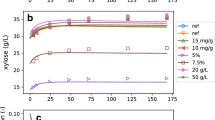Abstract
The uncatalyzed hydrolysis and removal of xylan from corn stover is markedly enhanced when operation is changed from batch to continuous flow through conditions, and the increase in hemicellulose removal with flow rate is inconsistent with predictions by widely used first-order kinetic models. Mass transfer or other physical effects could influence the hydrolysis rate, and two models reported in the literature for other applications were adapted to investigate whether incorporation of mass transfer into the kinetics could explain xylan removal in both batch and continuous flow through reactors on a more consistent basis. It was found that a simple leaching model and a pore diffusion/leaching model could describe batch and flow through data with accuracy similar to that of conventional batch models and could provide a more rational explanation for changes in performance with flow rate.
Similar content being viewed by others
References
Wyman, C. E. (1999), Annu. Rev. Energy Environ. 24, 189–226.
Jacobsen, S. E. and Wyman, C.E. (2000), Appl. Biochem. Biotechnol. 84–86, 81–96.
Jacobsen, S. E. and Wyman, C. E. (2002), Ind. Eng. Chem. Res. 41(6), 1454–1461.
Brennan, M. A., Liu, C., Wyman, C. E., and Yang, B. (2002), in 24 th Symposium on Biotechnology for Fuels and Chemicals, Oral presentation 3-02, Gatlinburg, TN
Bobleter, O. (1994), Prog. Polym. Sci. 19, 797–841.
Fogler, H. S. (1999), Elements of Chemical Reaction Engineering, 3rd Ed., Prentice Hall, Upper Saddle River, NJ.
Abatzoglou, N., Chornet, E., Belkacemi, K., and Overend, R. (1992), Chem. Eng. Sci. 47(5), 1109–1122.
Saeman, J. F. (1945), Ind. Eng. Chem. 37, 42–52.
Lee, Y. Y., Iyer, P., and Torget, R. W. (1999), Adv. Biochem. Eng. Biotechnol. 65, 93–115.
Kobayashi, T. and Sakai, Y. (1956), Bull. Agric. Chem. Soc. Jpn. 20, 1–7.
Mehlberg, R. and Tsao, G. T. (1979), in Abstracts of Papers of 178 th ACS National Meeting, American Chemical Society, Washington, DC, p. 36.
Garrote, G., Dominguez, H., and Parajó, J. C. (1999), Holz als Roh- und Werkstoff 57, 192–202.
Stuhler, S. L. (2002), MS thesis, Thayer School of Engineering, Dartmouth College, Hanover, NH.
Plawsky, J. L. (2001), Transport Phenomena Fundamentals, Marcel Dekker, New York, NY.
Cao, J., Tao, S., and Li, B. G. (1999), Chemosphere 39(11), 1771–780.
Author information
Authors and Affiliations
Corresponding author
Rights and permissions
About this article
Cite this article
Brennan, M.A., Wyman, C.E. Initial evaluation of simple mass transfer models to describe hemicellulose hydrolysis in corn stover. Appl Biochem Biotechnol 115, 965–976 (2004). https://doi.org/10.1385/ABAB:115:1-3:0965
Issue Date:
DOI: https://doi.org/10.1385/ABAB:115:1-3:0965




